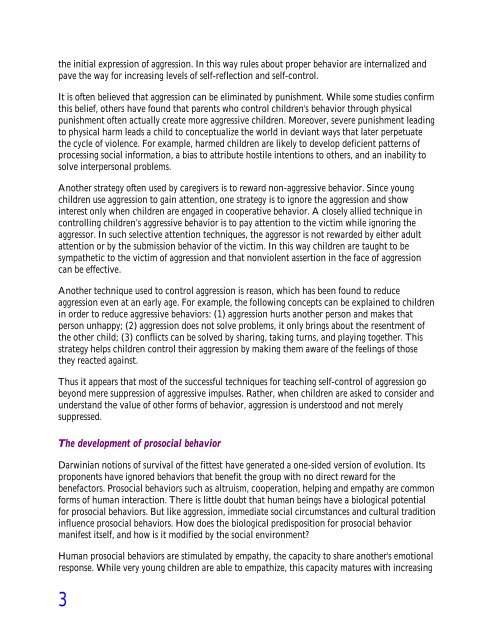the development of aggression and prosocial behavior in
the development of aggression and prosocial behavior in
the development of aggression and prosocial behavior in
Create successful ePaper yourself
Turn your PDF publications into a flip-book with our unique Google optimized e-Paper software.
<strong>the</strong> <strong>in</strong>itial expression <strong>of</strong> <strong>aggression</strong>. In this way rules about proper <strong>behavior</strong> are <strong>in</strong>ternalized <strong>and</strong><br />
pave <strong>the</strong> way for <strong>in</strong>creas<strong>in</strong>g levels <strong>of</strong> self-reflection <strong>and</strong> self-control.<br />
It is <strong>of</strong>ten believed that <strong>aggression</strong> can be elim<strong>in</strong>ated by punishment. While some studies confirm<br />
this belief, o<strong>the</strong>rs have found that parents who control children's <strong>behavior</strong> through physical<br />
punishment <strong>of</strong>ten actually create more aggressive children. Moreover, severe punishment lead<strong>in</strong>g<br />
to physical harm leads a child to conceptualize <strong>the</strong> world <strong>in</strong> deviant ways that later perpetuate<br />
<strong>the</strong> cycle <strong>of</strong> violence. For example, harmed children are likely to develop deficient patterns <strong>of</strong><br />
process<strong>in</strong>g social <strong>in</strong>formation, a bias to attribute hostile <strong>in</strong>tentions to o<strong>the</strong>rs, <strong>and</strong> an <strong>in</strong>ability to<br />
solve <strong>in</strong>terpersonal problems.<br />
Ano<strong>the</strong>r strategy <strong>of</strong>ten used by caregivers is to reward non-aggressive <strong>behavior</strong>. S<strong>in</strong>ce young<br />
children use <strong>aggression</strong> to ga<strong>in</strong> attention, one strategy is to ignore <strong>the</strong> <strong>aggression</strong> <strong>and</strong> show<br />
<strong>in</strong>terest only when children are engaged <strong>in</strong> cooperative <strong>behavior</strong>. A closely allied technique <strong>in</strong><br />
controll<strong>in</strong>g children’s aggressive <strong>behavior</strong> is to pay attention to <strong>the</strong> victim while ignor<strong>in</strong>g <strong>the</strong><br />
aggressor. In such selective attention techniques, <strong>the</strong> aggressor is not rewarded by ei<strong>the</strong>r adult<br />
attention or by <strong>the</strong> submission <strong>behavior</strong> <strong>of</strong> <strong>the</strong> victim. In this way children are taught to be<br />
sympa<strong>the</strong>tic to <strong>the</strong> victim <strong>of</strong> <strong>aggression</strong> <strong>and</strong> that nonviolent assertion <strong>in</strong> <strong>the</strong> face <strong>of</strong> <strong>aggression</strong><br />
can be effective.<br />
Ano<strong>the</strong>r technique used to control <strong>aggression</strong> is reason, which has been found to reduce<br />
<strong>aggression</strong> even at an early age. For example, <strong>the</strong> follow<strong>in</strong>g concepts can be expla<strong>in</strong>ed to children<br />
<strong>in</strong> order to reduce aggressive <strong>behavior</strong>s: (1) <strong>aggression</strong> hurts ano<strong>the</strong>r person <strong>and</strong> makes that<br />
person unhappy; (2) <strong>aggression</strong> does not solve problems, it only br<strong>in</strong>gs about <strong>the</strong> resentment <strong>of</strong><br />
<strong>the</strong> o<strong>the</strong>r child; (3) conflicts can be solved by shar<strong>in</strong>g, tak<strong>in</strong>g turns, <strong>and</strong> play<strong>in</strong>g toge<strong>the</strong>r. This<br />
strategy helps children control <strong>the</strong>ir <strong>aggression</strong> by mak<strong>in</strong>g <strong>the</strong>m aware <strong>of</strong> <strong>the</strong> feel<strong>in</strong>gs <strong>of</strong> those<br />
<strong>the</strong>y reacted aga<strong>in</strong>st.<br />
Thus it appears that most <strong>of</strong> <strong>the</strong> successful techniques for teach<strong>in</strong>g self-control <strong>of</strong> <strong>aggression</strong> go<br />
beyond mere suppression <strong>of</strong> aggressive impulses. Ra<strong>the</strong>r, when children are asked to consider <strong>and</strong><br />
underst<strong>and</strong> <strong>the</strong> value <strong>of</strong> o<strong>the</strong>r forms <strong>of</strong> <strong>behavior</strong>, <strong>aggression</strong> is understood <strong>and</strong> not merely<br />
suppressed.<br />
The <strong>development</strong> <strong>of</strong> <strong>prosocial</strong> <strong>behavior</strong><br />
Darw<strong>in</strong>ian notions <strong>of</strong> survival <strong>of</strong> <strong>the</strong> fittest have generated a one-sided version <strong>of</strong> evolution. Its<br />
proponents have ignored <strong>behavior</strong>s that benefit <strong>the</strong> group with no direct reward for <strong>the</strong><br />
benefactors. Prosocial <strong>behavior</strong>s such as altruism, cooperation, help<strong>in</strong>g <strong>and</strong> empathy are common<br />
forms <strong>of</strong> human <strong>in</strong>teraction. There is little doubt that human be<strong>in</strong>gs have a biological potential<br />
for <strong>prosocial</strong> <strong>behavior</strong>s. But like <strong>aggression</strong>, immediate social circumstances <strong>and</strong> cultural tradition<br />
<strong>in</strong>fluence <strong>prosocial</strong> <strong>behavior</strong>s. How does <strong>the</strong> biological predisposition for <strong>prosocial</strong> <strong>behavior</strong><br />
manifest itself, <strong>and</strong> how is it modified by <strong>the</strong> social environment?<br />
Human <strong>prosocial</strong> <strong>behavior</strong>s are stimulated by empathy, <strong>the</strong> capacity to share ano<strong>the</strong>r's emotional<br />
response. While very young children are able to empathize, this capacity matures with <strong>in</strong>creas<strong>in</strong>g<br />
3
















